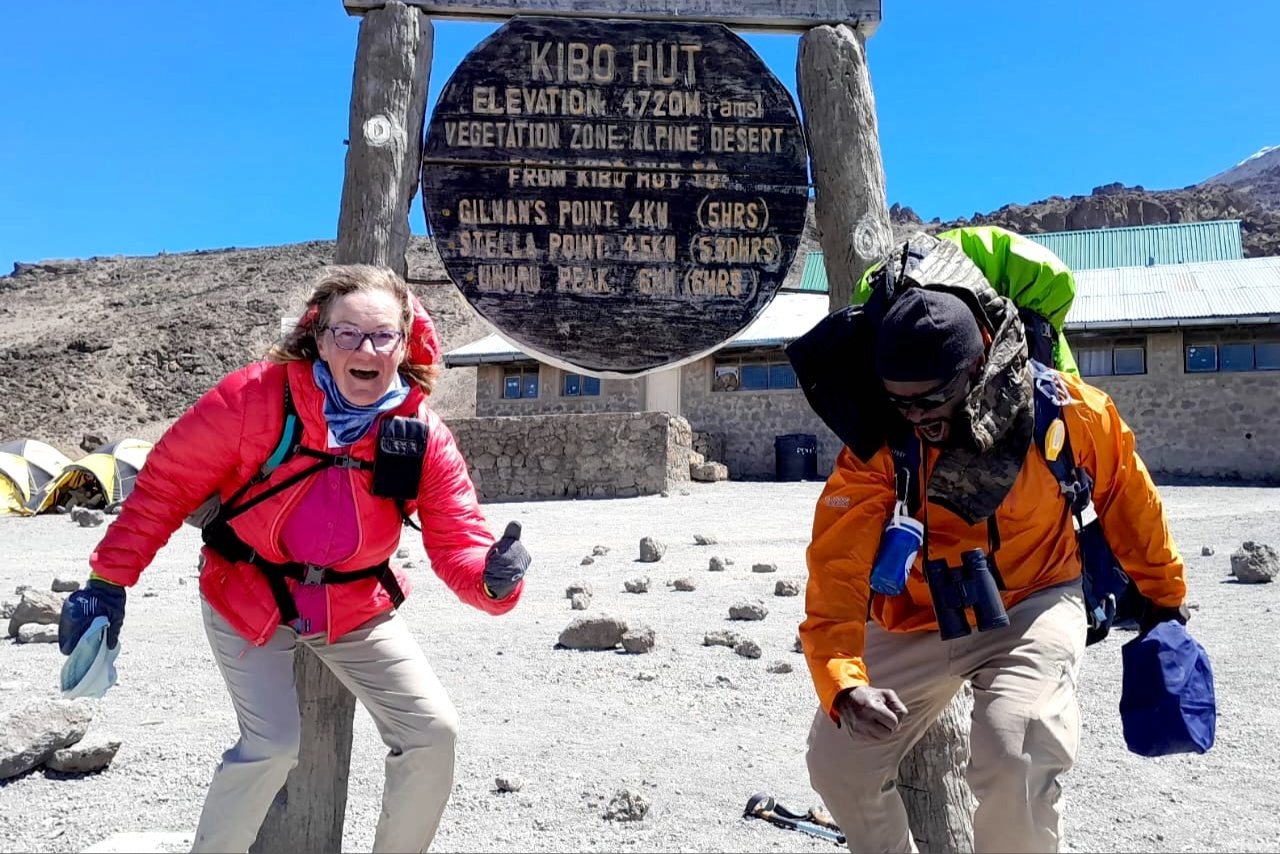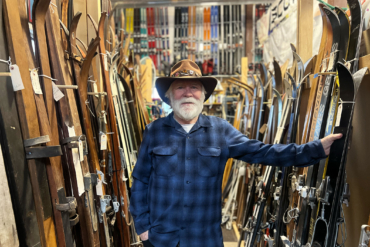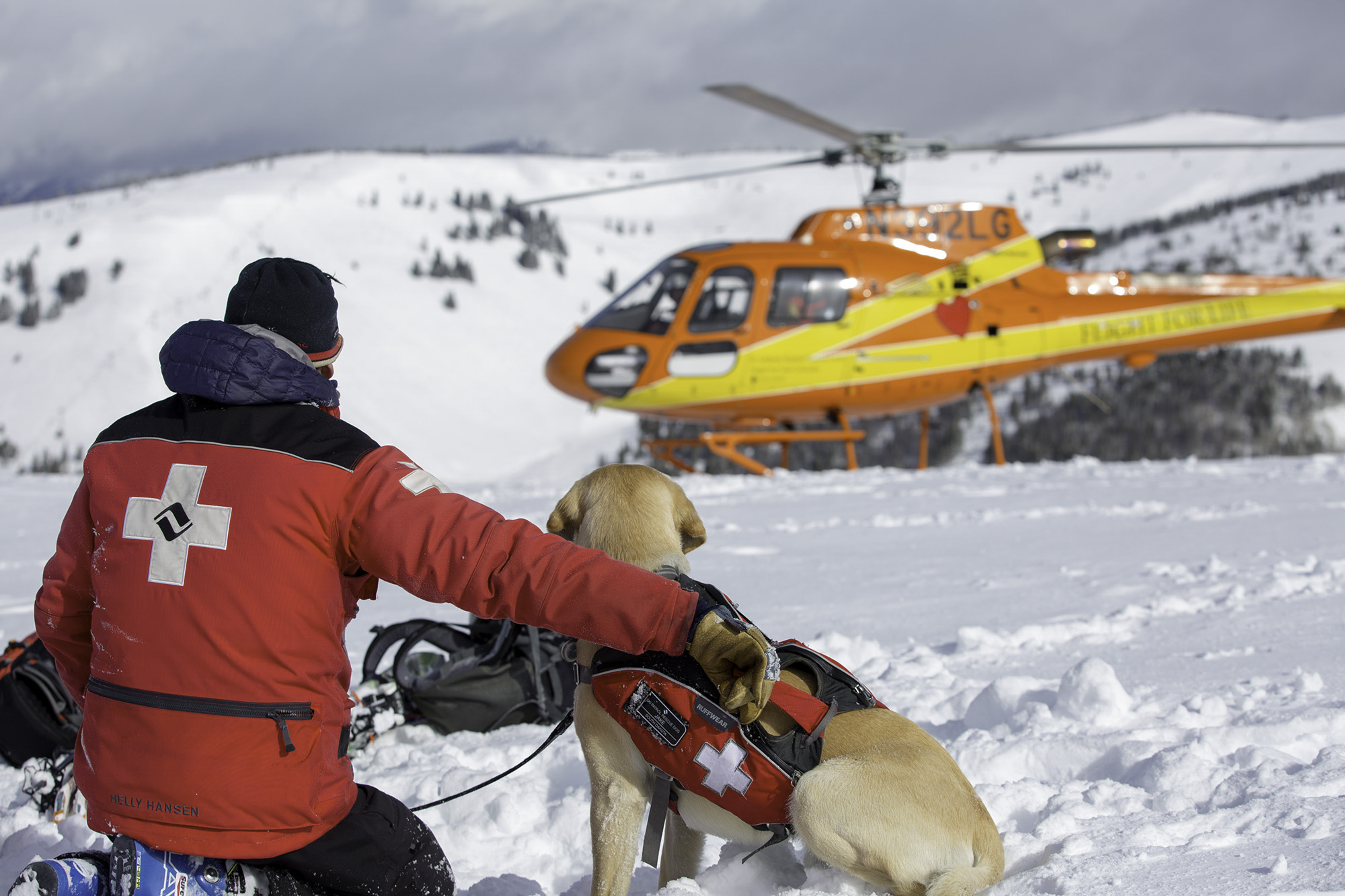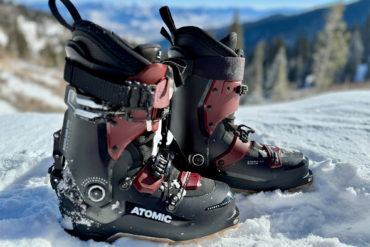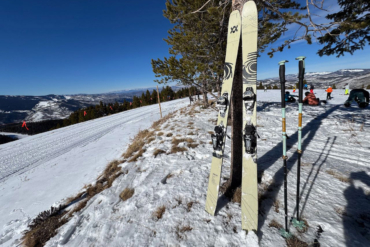The first thing I learned about Anna DeMonte was that on June 5, she set the women’s supported fastest known time (FKT) for skiing up and down Mont Blanc in Chamonix, France. The second thing I learned was that she only started skiing 4 years ago.
When I reached out over WhatsApp to ask her for an interview, she responded with a photo of her snowplowing down a hill on skis, holding her poles in front of her like a tractor-trailer steering wheel.
It was an accident. She’d been texting someone else at the same time and sent me the photo instead.
“That was me learning to ski in 2020,” she said in an attempt to explain herself.
Naturally, when we connected later, that was the first thing I wanted to ask her about. DeMonte is far from unknown — she is a sponsored trail runner for SCOTT and Rab Equipment. But she just skied one of the most deadly mountains in the world, and the largest mountain in the European Alps in just 7 hours and 29 minutes. Typically it takes people 2 to 3 days.
By all measures, she’s pretty capable on skis. So, I was extremely curious to know what had driven her to start and how she’d become such a pro so quickly.

What she told me made me respect her and this FKT even more. DeMonte has never attempted any sort of record like this before. But she used to be extremely competitive until health problems derailed her from that path. Mont Blanc is far from the hardest obstacle she’s overcome. In fact, she said this may have only rekindled a fire in her that she wasn’t sure was still burning.
“I honestly didn’t know if an FKT was something I could do because I didn’t really consider competition or being competitive in my future anymore,” she said. “But as the winter went on, I was like, ‘No. I actually think I can do this.'”
So, around 4:15 a.m. on June 5, after months of training, more gear testing and research than she’s ever done before, and at least one thwarted attempt, DeMonte took off running from the center of Chamonix, her skis and gear strapped to her back as bleary-eyed early-morning onlookers watched in confusion. She sprinted out of town and toward the looming mountain beyond.
She would return successful — the first woman ever to set a ski FKT on Mont Blanc.
Q&A With Anna DeMonte: Women’s Supported FKT Skiing Mont Blanc

GJ: So, you only started skiing in 2020. Is that true?
Anna DeMonte: I skied a couple of times as a kid growing up. I grew up in Michigan, and my family took me to go to Utah a couple of times, but I was a kid. I think the number of times I skied before I moved to Utah was under 10 — like, I could count the number on my hands. So, when I moved to Utah in 2020, I would say I was learning how to ski.
How did you get from there to attempting a supported FKT skiing Mont Blanc in just 4 seasons?
So I was a swimmer for 17 years and [in college]. Then, after college, I was a cyclist — road biking — and I got injured pretty badly. I had a spine injury, and so I stopped. I needed surgery, and it was actually a pretty bad situation … So that was the height of my cycling career. I actually, for a moment, thought I was going to be a pro cyclist. But the surgery basically changed that in a day. This was in 2017.
For someone who’s so active and was always a competitor and athlete, it turned my world upside down. Which I actually think was good for me in the end … but athletics and competition was just basically pulled out from under me, and it was devastating. Like, that was my whole identity.

How did that lead you to Utah?
I was healing and I was going on walks, I just felt like I’d be happier in the mountains. Maybe I could return to movement with some new activities … I also had some family in Utah and so I moved.
But I honestly did not plan on becoming super intense, like, competing or racing again because of the surgery. And having swam competitively for so long, I think it kinda burned me out. So I actually didn’t have intentions of doing this when I originally moved to Utah.
So what changed, then?
Immediately, backcountry skiing just seemed like the coolest thing to me. I have this aerobic base that I built up for so many years that helped, but there were so many problems. I wasn’t a good skier. And the first two seasons I lived in Utah, we had pretty bad snow years. And I was on skis that weren’t the right size exactly … But even though I was supposed to move there to have a more chill relationship with movement, I just got the bug.
And slowly from 2020 until now, I have, I guess, probably quickly progressed. But I put a lot of time into learning how to ski and the safety, which is super-important to me, and then the skills like ice climbing or rock climbing and rope work, crevasse rescue, all that kind of stuff. There’s so much you can learn in mountains and that just captured me.
But then you asked about the FKT specifically?

Yes. How did you get from learning to ski to the FKT?
A couple of years ago, I ticked off a few lines in Utah that, when I moved there, I’d never thought I’d be able to ski … I came to Chamonix originally just hoping to ski some of the steeper ski lines … I was in France for a work meeting, to be honest … but then Jack, my boyfriend, partner, whatever you want to call him, he also wanted to go to Chamonix … So he actually picked me up from my work event in the Sprinter van we bought in London.
I hadn’t really thought about Mont Blanc as a record. I haven’t even done any other FKTs before. But when you see Mont Blanc, it’s striking. I hate using those words like ‘breathtaking’ or ‘striking’ because they’re overused, but it’s imposing. It’s just this huge mountain that towers over the town, and it’s very glaciated.
Jack was going for the FKT for the men so we were training a lot together. And I think I was just inspired by the enormity of the mountain. Then secondly, there hadn’t been a lot of women that had recorded fast times … And I was like, well, someone’s gotta go put up a fast time for the women for skiing. And so, why not me?

Which route did you end up choosing to take?
We both chose the Grands Mullet, and it [goes] from the church in the center of Chamonix to the top and back. That is the route that the men’s ski records have typically been done on. And that’s kind of the classic ski route. And I wanted to do that one. Though there are some dangers on it, there are some other routes that might be considered “safer.”
What was the lead-up to FKT day like?
I actually did an entire church-to-church a little over 2 weeks prior on a day Jack and I thought was the right day. And the conditions were not great … but I did finish it, and I kind of treated it as, like, a training lap. But I will say, I regret that a little bit because doing a whole Grands Mullet round trip, it stays in your legs for a while. So there was some fatigue left from that.
Our mood was really dependent on the weather forecast for about a month or two. Because it was so hard to find a day that was clear, and it was getting later in the season, and so that means crevasses were opening up, and the route was becoming more dangerous. We were just looking for any day that wasn’t terrible.
But this day, I was relieved. It was finally, like, we’re gonna just do it, and we’re gonna stop worrying about the conditions because it was probably the last day possible … so relief. And then, I guess the other thing when I woke up, I was thinking, like, ‘Wow. I haven’t gotten to compete or put myself out there in a long time since maybe cycling or swimming … I was grateful that I was able to even get up and do it.
And I was also kinda like, I’m gonna fucking go as fast as I can, and let’s see what happens.

Was there ever a moment on the route that you thought you weren’t going to make it?
No. I knew I’d make it to the end. It was more like how fast am I going to go? And the day we chose, unfortunately, was not perfect … It was so icy. I would say the conditions were horrible on the way up. So there were a couple of times that I considered failing just because I knew it wasn’t gonna be as fast as I could go.
Then I thought, ‘I don’t really care. If the time is not perfect, I’ll come back and I’ll do it again, and it’ll be faster next time.’

You’ve been on a pretty wild journey on your way to this FKT. What does the accomplishment mean to you?
Personally, for my own journey, it showed me that I am still competitive, and I will always be a competitor, and I enjoy that.
I’ll also say I used to be a little bit averse to the acronym ‘FKT.’ I think I had kind of a negative connotation to the term FKT prior to this … sometimes there’s a culture that lends itself to not caring. Like, ‘Oh, I don’t care what time I get. I’m just out there to have a good time with my friends in the mountains’ … Like it’s almost negative to say you want to go fast.
But I think it’s really vulnerable to say you’re going to go for something. Because there’s a chance for failure. And if you never care, you never have to confront a potential failure. So I actually admire when people are, like, ‘No. I’m gonna go for it.’ … You’re putting yourself out there.
So I came out of this realizing, it’s super cool to see someone go for [any FKT]. And putting that many months of effort into something to make it happen is admirable whether you get the time or not.
FKT Gear: Anna DeMonte’s Mont Blanc Kit

Obviously, when you’re attempting to ski a mountain like Mont Blanc faster than anyone before you, the gear you choose has a big effect on the outcome of your performance. DeMonte said dialing her kit was one of the most interesting and enjoyable parts of preparing for this FKT. During training, she and her partner tried a huge variety of different skis, crampons, poles, skins, ice axes, and so on.
“There’s just so many elements that you get to pick,” she said. “I think the gear side of ski mountaineering with a specific objective is one of the most fun parts … we talked about and debated about all winter and all spring, and I think it’s fun.”
DeMonte shared a detailed list of the gear she used to get to the top, and back down Mont Blanc in record time.
Clothing (All Rab)
“The goal with clothing was to manage the warm start and finish in town with the cold environment at the 15,771-foot summit,” DeMonte said. “Instead of using a typical skimo suit, I opted for a more layerable situation. I started with shorts underneath tights, a lightweight top, and a lightweight shell. That way, I could layer down to the shorts and top for the hot run back to the church.”
- Shorts under tights: Rab Women’s Talus Trail Light
- Tights over shorts: Rab Women’s Talus Windstopper Tights
- Top: Rab Women’s Sonic Ultra Tee
- Outer Shell: Rab Women’s Phantom Waterproof Pull-On Jacket
- Gloves: Rab Xenon Glove
Ice Axe
- Training: Blue Ice Bluebird and Petzl Gully
- FKT Day: Petzl Gully
“Petzl Gully was slightly lighter, and I found the TRIGREST handrest to instill a lot of confidence for the iciest section of the ridge toward the summit. This section required a full pitch of ice climbing with two axes on our first summit in April but was soloable with one axe by June.”
Crampons
- Trained/tested with Blue Ice Harfang, Petzl Lynx, and Petzl Irvis Hybrid
“Went with Petzl Irvis Hybrid on FKT day. I also removed the ankle retainer strap on the day of the FKT for faster transitions. In the early season, the Petzl Lynx was the best for the icier sections of the summit ridge, but by June, a lighter-weight crampon like the Irvis Hybrid or Harfang was plausible. I found the transitions with the Hybrid to be faster and easier than with the Harfang, though their performance was similar.”
Harness
- Trained with Blue Ice Choucas Light and Grivel Mistral
- Went with Blue Ice Choucas Light on FKT day
“Blue Ice Choucas Light was by far the easiest and lightest. Really impressed with the harness for doing a fast activity.”
On Harness

Ski Pack
- Trained and tested CAMP Rapid Racing Pack and Dynafit DNA 16
- Went with CAMP Rapid Racing Pack on FKT day
“The main reason for picking the CAMP pack was it had slightly better cushioning for the sharp gear I was carrying on the running sections. Since I carried one boot in the pack, crampons, etc., the sharp objects were constantly rubbing against my back on the run portions, and this pack fit slightly better for comfort.”
Everything Else
Running Belt: Compress Sport Free Belt Pro
“I needed a belt to have my soft flasks and nutrition easily available because there was no flask storage in the pack. It was quite uncomfortable to ski with a harness and a running belt over it, but this was the best option for keeping nutrition close.”
- Helmet: Black Diamond Vapor Helmet
- Sunglasses: SCOTT Sports Torica Light Sensitive
- Boots: SCARPA Alien 1.0 – Women’s
“I trained in these [boots] all season and grew to love them. When I am not wearing these, I use the Fischer Transalp Pro.”
- Skis: Dynafit DNA – 153
“I used the Dynafits for FKT day, but most of the season was training on SCOTT Proguide 89.”
- Skins: Pomoca Race
- Ski Bindings: Ski Trab Gara Titan
- Poles: SCOTT Sports Pure Adjust SRS Poles
- Headlamp: Petzl Swift RL
- Running Shoes: SCOTT Sports Supertrac RC prototype. Usually running on the SCOTT Sports Supertrac RC 2.

DeMonte said she caught the FKT bug. She’s already setting her sights on her next objective — Mount Denali in Alaska or Rainier in Washington. To follow her future adventures, check out Anna DeMonte’s Instagram (@anna.demonster).

